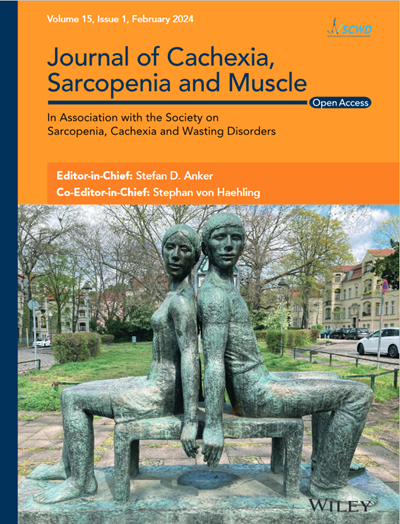Adiposity is associated with widespread transcriptional changes and downregulation of longevity pathways in aged skeletal muscle
Abstract
Background
Amongst healthy older people, a number of correlates of impaired skeletal muscle mass and function have been defined. Although the prevalence of obesity is increasing markedly in this age group, information is sparse about the particular impacts of obesity on ageing skeletal muscle or the molecular mechanisms that underlie this and associated disease risk.
Methods
Here, we examined genome-wide transcriptional changes using RNA sequencing in muscle biopsies from 40 older community-dwelling men from the Hertfordshire Sarcopenia Study with regard to obesity (body mass index [BMI] >30 kg/m2, n = 7), overweight (BMI 25–30, n = 19), normal weight (BMI < 25, n = 14), and per cent and total fat mass. In addition, we used EPIC DNA methylation array data to investigate correlations between DNA methylation and gene expression in aged skeletal muscle tissue and investigated the relationship between genes within altered regulatory pathways and muscle histological parameters.
Results
Individuals with obesity demonstrated a prominent modified transcriptional signature in muscle tissue, with a total of 542 differentially expressed genes associated with obesity (false discovery rate ≤0.05), of which 425 genes were upregulated when compared with normal weight. Upregulated genes were enriched in immune response (P = 3.18 × 10−41) and inflammation (leucocyte activation, P = 1.47 × 10−41; tumour necrosis factor, P = 2.75 × 10−15) signalling pathways and downregulated genes enriched in longevity (P = 1.5 × 10−3) and AMP-activated protein kinase (AMPK) (P = 4.5 × 10−3) signalling pathways. Furthermore, differentially expressed genes in both longevity and AMPK signalling pathways were associated with a change in DNA methylation, with a total of 256 and 360 significant cytosine–phosphate–guanine–gene correlations identified, respectively. Similar changes in the muscle transcriptome were observed with respect to per cent fat mass and total fat mass. Obesity was further associated with a significant increase in type II fast-fibre area (P = 0.026), of which key regulatory genes within both longevity and AMPK pathways were significantly associated.
Conclusions
We provide for the first time a global transcriptomic profile of skeletal muscle in older people with and without obesity, demonstrating modulation of key genes and pathways implicated in the regulation of muscle function, changes in DNA methylation associated with such pathways and associations between genes within the modified pathways implicated in muscle regulation and changes in muscle fibre type.

 求助内容:
求助内容: 应助结果提醒方式:
应助结果提醒方式:


